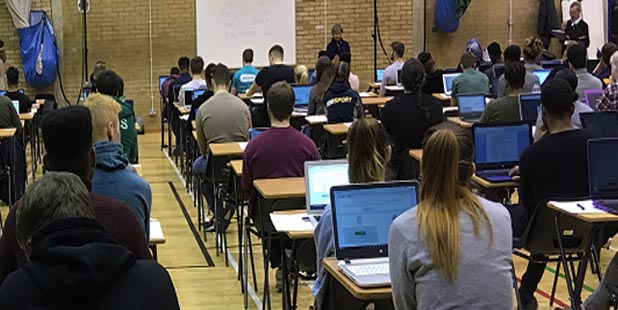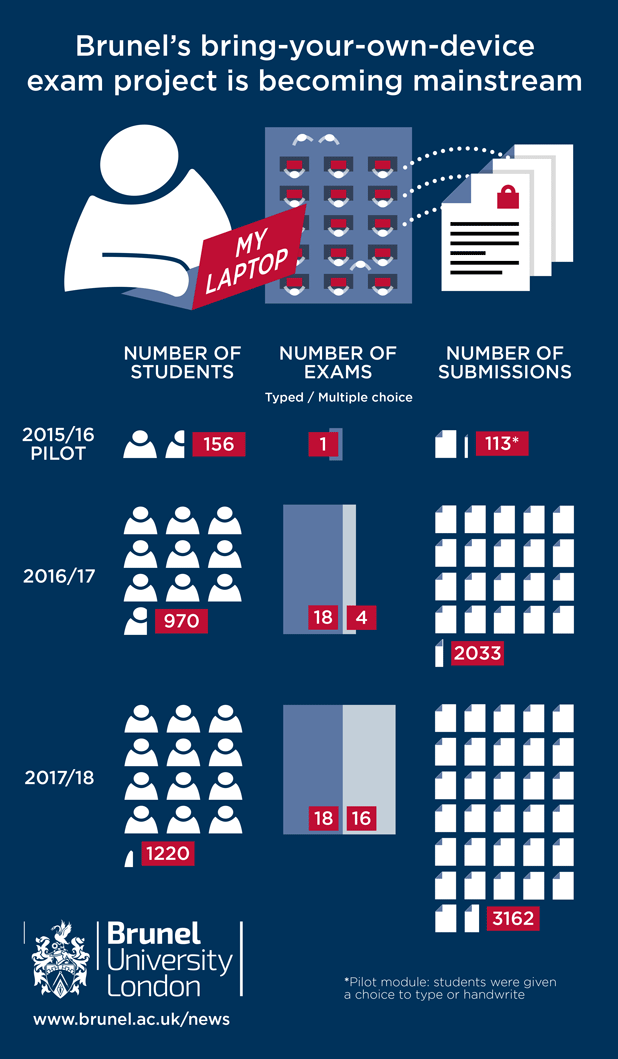By Alice La Rooy (Head of Digital Education, Brunel University London), Dr Simon Kent (Director of Learning & Teaching for Computer Science, Brunel University London) and Professor Mariann Rand-Weaver (Pro-Vice-Chancellor (Education), Brunel University London)

From the comfort of their own laptops, over 1000 students at Brunel University London sat their exams this summer as part of the UK's largest 'bring your own device' exam project – and all evidence points to this initiative expanding across the HE sector.
A growing number of Brunel students have been able to bring their own devices to the exam hall since 2015 to take a variety of exams, from essay questions to multiple-choice. This led to Hefce awarding us funding to investigate the feasibility of scaling up digital examinations, and to document and share best practice with the sector.
The benefits are immediately identifiable and compelling, for students and for staff.
The procedure is easy and secure. In advance of their exams, students install a lockdown browser on their laptops which, come the exam time, prevents access to any other applications, although access to chosen websites can be allowed if required. The password-protected exam script is kept secure online and is only available during the exam.
For our invigilators, gone are the days of counting papers before students can leave the exam hall. A quick check on screen confirms that all students have submitted their work – especially useful for large exams of over 250 students, when the submissions can be counted in seconds. The obvious environmental benefits of not printing reams of papers are boosted by not having to wheel exam scripts back and forth across campus in trolleys. Markers also have no delay in receiving the exam papers and no longer have to coordinate with colleagues to meet up and swap scripts for marking and/or moderation.
Students are now entering HE with expectations set by increasing use of technology in their secondary schooling. Some studies suggest that students type faster than they can write, and being able to edit and reorganise ideas in exam scripts comes natural to a generation of students who otherwise are not required to hand-write pieces of work. The students can create simple drawings electronically or capture hand-drawn diagrams using their device's webcam, but ditching pen and paper for the written elements of the exam cuts down on hand cramp. And faster turnaround at the end of exams means students can head out from the hall quicker.

We have shared these benefits with visitors from other UK universities, both at a workshop and conference we have hosted, or during ad-hoc observations of the system in practice during exams. And we have explained how to overcome potential barriers to adoption, such as ensuring a strong Wi-Fi signal throughout the exam hall, providing spare laptops for students who are unable to bring their own, and ensuring that reasonable adjustments are made for students with additional needs.
It is also clear that BYOD exams are more scalable, more flexible and less costly than solutions where fixed-point PCs are provided to all exam-takers.
Any technological solution in education brings with it concerns about security, technical failure and possibilities for cheating. Our years of experience with BYOD exams have reassured us that exam scripts are regularly saved to secure cloud storage, that students can successfully move to a Brunel device if required, and that the lockdown functionality limits students to the task at hand.
It remains true that more complex text – such as mathematical input and chemical equations – is currently much more time-consuming to type than it is to write, even for experienced users. So some subjects will be much better suited to handwritten exams until technology catches up. But at Brunel we will continue to roll out BYOD exams beyond the five subjects we have focused on so far, expanding the benefits to thousands more students and plenty more staff.
In the future, we hope to take advantage of statistics gathered through BYOD exams to make adjustments, where necessary, to exam length or format, and to adjust associated processes so we can return marks to students sooner, passing on time savings to them.
We are, of course, aware of and part of the ongoing debate about the usefulness of exams as an assessment method. At Brunel, we continue to review our assessments and make them as authentic as possible. But as long as exams are still a significant assessment method across the HE sector, it is crucial for us to improve them and the experience – for students and for staff. As our experience has shown, BYOD exams and full digital assessment are ready for the mainstream.

Brunel University London uses a lockdown browser and digital exam platform from WISEflow.
This article was originally written for Education Technology.